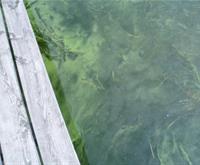Floating Pollen
Every year, during May and June, the SSEA office receives inquiries about a yellow scum, floating in sheltered areas of Severn Sound and near by lakes. This is a natural phenomenon that occurs in most of Northern Ontario where a forest ecosystem is prevalent.
During spring and early summer, trees such as pine and birch release pollen in large quantities. Pollen grains are very small, and are easily carried with the wind to water surfaces. This surface cover is yellowish in colour, and may appear like a paint slick or algae bloom from a distance. It can also appear as clumps, and may collects in coves, or stain rocks as water levels drop later in the summer. On the water surface, the pollen grains become waterlogged, and sink to the bottom. In fact, it is this annual release and settling of pollen that allows scientists to determine past climate conditions using lake sediment cores by determining what tree species the pollen originated from, and in what quantities it is present.



